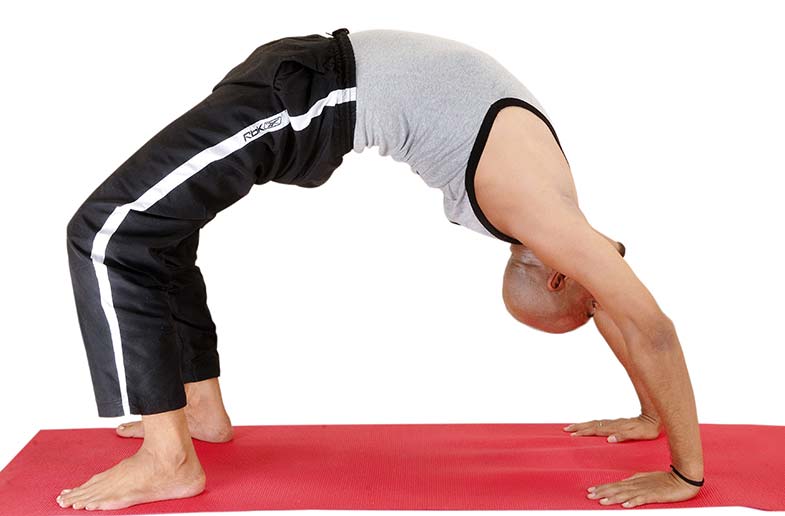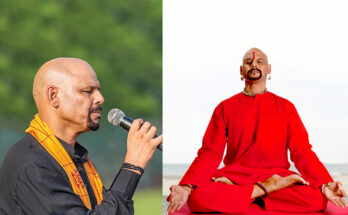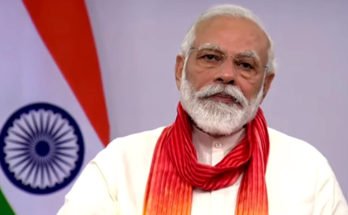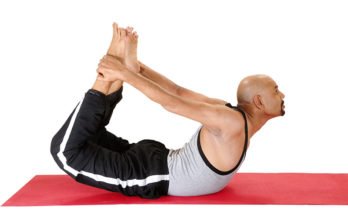Yogic Healing demonstration. Chakrasana by Yogaguru Suneel Singh.
Go Yogic healing yoga is designed in such a way that it helps to improve stamina, strength, flexibility, confidence and mental wellbeing. And just by practicing these 5 yoga process you will remain healthy.
1. Shambhavi Mudra: Sit down any comfortable meditation pose keep the head, shoulder and spine upright and straight. And place the hands on the knees in (Gyana Mudra). Close the eyes and relax the whole body. Now look up word and in ward, focusing the eyes at the eyebrow centre. Hold the gaze as long as you are comfortable. Release if the slightest sensation or strain. Close the eyes and relax them. Try to do 5 minutes daily.
Benefits: This Mudra strengthen they eyes muscles and release accumulated tension in the area. It develops concentration, mental stability and the state of thought lessees. All ailments headache, sleeplessness, excessive sleep and eyes complications are cured. Shambhavi Mudra is the first way of Yogic Healing.
Caution: People suffering from cataract surgery, glaucoma and eye operations should not perform Shambhavi Mudra. For advance practitioner it is a powerful technique for awakening Agya Chakra.
Read: Yoga to defy Aging
2. Tadasana: It is wonderful for improving your posture and alignment, toning the spinal nerves, and creating a sense of awareness through the body. It can be used as a resting pose or a preparatory pose for almost any standing asana.
Stand with your feet together with the big toes and heals touching. Ensure that your toes are in alignment. If this is uncomfortable or causes instability, give your feet several inches of room, but no wider than hip width apart.
Lift the toes into the air, spreading them out then planting firmly into the ground. Center your body so that you feel your weight evenly distributed through the bottom of your feet.
Firm the legs without locking the knees. Pull the ankles slightly apart lifting the arches of your feet. Feel the grounding of your body through the legs as you root them into your feet and into the ground.
Arms are relaxed at the side of the body; shoulders pull slightly away and back from the ears opening the chest. Pull the pubic bone inward allowing the tailbone to point towards the floor, lengthening the entire spine through the neck and top of the head.
Read: Yoga and Arthritis
Standing still, go through the body with your mind and your breath, starting with your toes and travel up through your ankles, legs, pelvis, abdomen, chest, shoulders, neck and head. Here use your “internal mirror” making tiny adjustments to align the pelvis, chest and head. This will create a feeling of being totally within your body. Eyes can be open looking straight ahead or for more of a challenge closed.
In the final phase of this pose, your chin should be level with the floor. Stay with the breath. Use the breath to enhance the sensations in the body.
Benefits: Improves alignment and corrects poor posture. Strengthens ankles and feet; firms thighs and buttocks. Helps relieve shortness of breath, especially in pregnancy. Tadasana is the second way of Yogic Healing.
Caution: For those who may need extra support, it may be helpful to stand against a wall with your sacrum and shoulder blades lightly touching the wall or stand facing the wall using your hands for support.
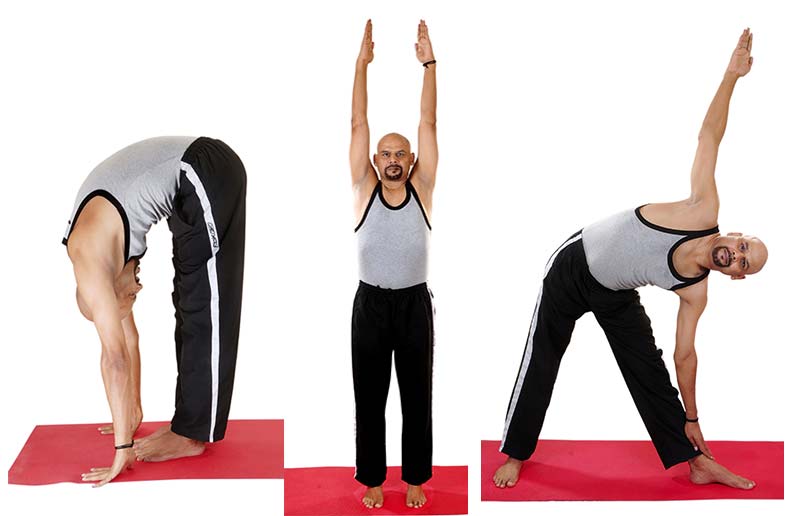
Padahastasana (Left), Tadasana (Middle) and Trikonasana (Right).
3. Trikonasana: Standing in Tadasana, walk your feet apart approximately 4 feet. You want your legs to feel stable; avoid extending too much.
Turn your right foot out 90 degrees and turn your left foot toward the right about 30 degrees. The right heal is in line with the back of the arch and heal of the left foot. The right knee should be in line with the right ankle. Take a few breaths to balance and settle into this stance.
Inhale and lift your arms out to the side at shoulder height, level with the ground. Palms are faced down. With an in-breath, lengthen the spine and lift the chest. Look straight ahead.
Exhale and then reach to the right, allowing your hips to shift to the left. Slowly drop your right arm toward the lower leg, while stretching the left arm up toward the sky. Move within the feeling of having a pane of glass in front of you and one behind you. Stay within this imaginary field. It doesn’t matter how far you come down.
Rest your hand either on your thigh, shinbone or ankle. If you can comfortably reach the floor, place the hand on the outside of the right foot. Ground your legs into the floor, especially pressing through the back left heel.
Extend through the sides of the neck to keep the head straight. Keep head as is or look upward toward your left thumb. Open the chest; lengthen from the left fingers through the chest, down to the right fingers. The shoulders should be in alignment with each other. Inhale and exhale evenly.
To emerge from the posture, inhale and lift the torso up. Use your left arm to lift your body and steady your movement. Exhale the arms down. Turn your feet forward, then onto the other side. Walk your feet back together into Tadasana.
Benefits: Strengthens neck, shoulders, spine, legs and ankles. Improves circulation of the blood. Tones the spinal nerves. Eases backache, indigestion, flatulence and gastric problems. Trikonasana is the third way of Yogic Healing.
Caution: Be mindful of the head and neck; you may need to look down toward the floor in the final posture. If balance is too difficult, practice against a wall. Rest the raised arm either on the hip or slide the top of the hand behind you across the lower back to open the shoulder.
Read: Several ways of doing meditation
4. Padahastasana: “Pada” means ‘feet’ and “Hasta” means ‘hand’. In this pose the hands are brought to the feet to catch the toes.
Method: Feet must be parallel to each other. Inhale and raise both your hands straight above your head. The palms should be facing outwards. Exhale slowly and bend your head and neck down. Bend your trunk at the waist and push the head further downwards. Ensure that the knees do not bend and the arms are touching the ears.
Exhaling stretch your arms to catch the big toe of the corresponding legs. Use the thumb, index and middle finger to grasp the toes. If possible you can put the palms under the feet. Complete exhalation and hold your breath. Now pull your toes and place your head in between the knees. The knees should not bend at any time. Hold this position for some time. Inhaling slowly release your toes and raise your trunk to come back to the starting position.
Benefits: The benefits of Padahastasana are numerous. In this posture, there is great emphasis on the flow of blood to the head without the difficulties presented in other postures which also do so such as the headstand. Padahastasana is the fourth way of Yogic Healing.
Some key benefits:
(i) The toning of the abdominal organs
(ii) Conditions of bloating of the abdomen, constipation, indigestion and other gastric troubles can be greatly alleviated
(iii) Helps to relieve sciatica
(iv) The spine is made resilient, straight and flexible
(v) Circulation of the blood throughout the body is improved
(vi) The muscles of the back are stretched and energized, making one feel invigorated afterwards
5. Chakrasana (wheels pose): Lie flat on your back with legs straight on the floor. Bend your legs from the knees and with the help of the hands, bring the heels as close to the hips as possible slowly raise the body and arch the back, allowing the crown on the head to support the weight of the upper body. Putting pressure on the palms, raise your body from the floor arching the back straight then the knees further by moving the trunk towards the head let the body so the head rests on the floor and then lower the rest of the body. This is one round repeat 3 times.
Benefits: This asana tones up the nervous, digestive, respiratory, cardiovascular and glandular systems. This asana keep dislodged navel at its right position. Ram ban for back and neck pain. Chakrasana is the fifth way of Yogic Healing.
Caution: While lifting the body leave the neck loose or else there is fear of a sprain in the neck. People with any illness, during pregnancy, High blood pressure, Heart problem and weak wrists should not practice this asana.

